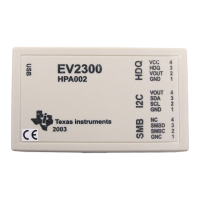Real-Time Data Exchange
Instrumentation 3-41
❏ Provide data buffering on the target. A copy of your data is stored in a
target buffer prior to being sent to the host. This action helps ensure the
integrity of the data and minimizes real-time interference.
❏ Provide interrupt safety. You can call the routines defined in the user
interface from within interrupt handlers.
❏ Ensure correct utilization of the communication mechanism. It is a
requirement that only one datum at a time can be exchanged between
the host and target using the JTAG interface. The routines defined in the
user interface handle the timing of calls into the lower-level interfaces.
3.8.3.4 RTDX Host OLE Interface
The OLE interface describes the methods that enable an OLE automation
client to communicate with the RTDX host library.
The functions defined in the OLE interface:
❏ Enable an OLE automation client to access the data that was recorded in
an RTDX log file or is being buffered by the RTDX Host Library
❏ Enable an OLE automation client to send data to the target via the RTDX
host library
3.8.4 RTDX Modes
The RTDX host library provides the following modes of receiving data from a
target application:
❏ Non-continuous. The data is written to a log file on the host.
Noncontinuous mode should be used when you want to capture a finite
amount of data and record it in a log file.
❏ Continuous. The data is simply buffered by the RTDX host library; it is
not written to a log file. Continuous mode should be used when you want
to continuously obtain and display the data from a DSP application, and
you don't need to store the data in a log file.
Note:
To drain the buffer(s) and allow data to continuously flow up from the target,
the OLE automation client must read from each target output channel on a
continual basis. Failure to comply with this constraint may cause data flow
from the target to cease, thus reducing the data rate, and possibly resulting
in channels being unable to obtain data. In addition, the OLE automation
client should open all target output channels on startup to avoid data loss
to any of the channels.

